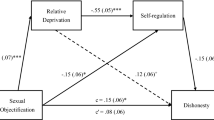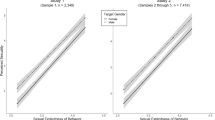Abstract
The current study compared the predictions of two socio-cultural theories, shifting standards and intergroup bias, to predict sexual double standards that occur in reactions to computer-mediated infidelity. Shifting standards theory (Biernat In The shifting standards model: Implications of stereotype accuracy for social judgment, APA, Washington DC, 1995) suggests that individuals will judge female targets more harshly than male targets, based on culturally ingrained stereotypes regarding sexual behavior. On the contrary, intergroup bias theory (Brewer In Psychol Bull 86:307–324, 1979) predicts that individuals will judge outgroup targets, or members of the opposite sex, more harshly than ingroup targets, or members of the same sex. Participants were shown a hard copy of presumable evidence that extradyadic computer-mediated behavior had occurred, engaged in by one of two members of a couple. The two groups differed only by the sex of the target, the female “Colleen” or the male “Bill”. Then participants reported their attitudes toward the target’s behavior, resulting distress, and likelihood to terminate the relationship. Results showed support for the intergroup bias theory, suggesting that individuals altered their attitudes toward the behavior based on whether the target was an ingroup or outgroup member.
Similar content being viewed by others
References
Allport, G. W. (1954). The nature of prejudice. Cambridge, Mass: Addison-Wesley.
Argyle, K., & Shields, R. (1996). Is there a body in the net? In R. Shields (Ed.), Cultures of Internet: Virtual spaces, real histories, living bodies (pp. 58–69). London: Sage.
Biernat, M. (1995). The shifting standards model: Implications of stereotype accuracy for social judgment. In Y. Lee, L. J. Jussim, & C. R. McCauley (Eds.), (pp. 86–114), Washington DC: APA.
Biernat, M., & Manis, M. (1994). Shifting standard and stereotype-based judgments. Journal of Personality & Social Psychology, 66(1).
Brewer, M. B. (1979). In-group bias in the minimal intergroup situation: A cognitive- motivational analysis. Psychological Bulletin, 86, 307–324.
Brewer, M. B., & Kramer, R. M. (1985). The psychology of intergroup behaviors and attitudes. Annual Review in Psychology, 36, 219–243.
Collins, L. (1999). Emotional adultery: Cybersex and commitment. Social Theory and Practice, 25(2), 243–271.
Cooper, A., Morahan-Martin, J., Mathy, R. M., & Maheu, M. (2002). Toward an increased understanding of user demographics in online sexual activities. Journal of Sex and Marital Therapy, 28(2), 105–129.
Crawford, M., & Popp, D. (2003). Sexual double standards: A review and methodological critique of two decades of research. The Journal of Sex Research, 40(1), 13–26.
Dew, B., Brubaker, M., & Hays, D. (2006). From the altar to the Internet: Married men and their online behavior. Sexual Addiction and Compulsivity, 13, 195–207.
Drudis, E. (1999). Sex, sex, sex, that’s all you ever sign on about. The Vancouver Sun, B11, 1–2.
Fiske, S. T., & Stevens, L. E. (1993). What’s so special about sex? Gender stereotyping and discrimination. In M. Costanzo & S. Oskamp (Eds.), Gender issues in contemporary society (pp. 173–196). Thousand Oaks, CA: Sage Publications.
Hackathorn, J. (2009). Beyond touching: The evolutionary theory and computer-mediated infidelity. The New School Psychology Bulletin, 6(1), 29–34.
Henline, B. H., Lamke, L. K., & Howard, M. D. (2007). Exploring perceptions of online infidelity. Personal Relationships, 14, 113–128.
Hertline, K. M., & Piercy, F. P. (2006). Internet infidelity: A critical review of the literature. The Family Journal, 14(4), 366–371.
Hewstone, M., Rubin, M., & Willis, H. (2002). Intergroup bias. Annual Review in Psychology, 53, 575–604.
Maheu, M. M., & Subotnik, R. B. (2001). Infidelity on the Internet: Virtual relationships and real betrayal. Naperville: Sourcebooks, Inc.
Milhausen, Herold. (1999). Does the sexual double standard still exist? Perceptions of university women. The Journal of Sex Research, 36(4), 361–368.
Navarrete, C. D., Fessler, D. M. T., Fleischman, D., & Geyer, J. (2009). Race bias tracks conception risk across the menstrual cycle. Psychological Science, 20, 661–665.
Paul, L., Foss, M. A., & Baenninger, M. A. (1996). Double standards for sexual jealousy: Manipulative morality or a reflection of evolved sex differences? Human Nature, 7(3), 291–321.
Pines, A. M., & Friedman, A. (1998). Gender differences in romantic jealousy. Journal of Social Psychology, 138(1), 54–72.
Preacher, K. J., & Hayes, A. F. (2004). SPSS and SAS procedures for estimating indirect effects in simple mediation models. Behavior Research Methods, Instruments, and Computers, 36, 717–731.
Rutchik, A. M., & Eccleston, C. P. (2010). Ironic effects of invoking common ingroup identity. Basic and Applied Social Psychology, 32(2), 109–117.
Safilios-Rothschild, C. (1977). Love sex, and sex roles. Englewood Cliffs. NJ: Prentice-Hall.
Spreadbury, C. L. (1982). The “permissiveness with affection” norm and the labeling of deviants. Personnel and Guidance Journal, 60, 280–282.
Tajfel, H. (1982). Social psychology of intergroup relations. Annual Review of Psychology, 33, 1–39.
Turner, J. C., Oakes, P. J., Haslam, S. A., & McGarty, C. (1994). Self and collective: Cognition and social context. Personality and Social Psychology Bulletin, 20, 454–463.
Vonk, R., & Olde-Monnikhof, M. (1998). Gender subgroups: Intergroup bias within the sexes. European Journal of Social Psychology, 28, 37–47.
Weiderman, M. W. (1997). Extramarital sex: Prevalence and correlates in a national Survey. Journal of Sex Research, 34(2), 167–175.
Weiderman, M. W., & Allgeier, E. R. (1993). Gender differences in sexual jealousy: Adaptationist or social learning explanation? Ethology and Sociobiology, 14, 115–140.
Whitty, M. T. (2003). Pushing the wrong buttons: Men’s and women’s attitudes toward online and offline infidelity. CyberPsychology and Behavior, 6(6), 570–579.
Wilder, D. A. (1981). Perceiving persons as a group: Categorization and intergroup relations. In D. L. Hamilton (Ed.), Cognitive processes in stereotyping and intergroup behavior (pp. 213–257). Hillsdale, NJ: Erlbaum.
Author information
Authors and Affiliations
Corresponding author
Rights and permissions
About this article
Cite this article
Hackathorn, J., Harvey, R. Sexual Double Standards: Bias in Perceptions of Cyber-Infidelity. Sexuality & Culture 15, 100–113 (2011). https://doi.org/10.1007/s12119-010-9082-x
Published:
Issue Date:
DOI: https://doi.org/10.1007/s12119-010-9082-x




